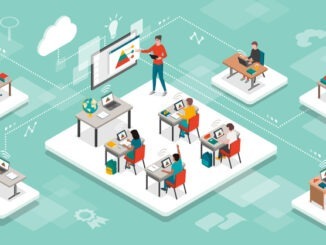
Neil Limbrick, partner and IT consultant, Limbrick Consultancy LLP, founder of theEducationCollective and ambassador for the Association of Network Managers in Education, gives his top tips on how to segment your IT planning
Read the full article below or on page 30 in our February magazine
As I write this my internet access at home is down. I am sitting in the dark because the lights in my office are controlled by a smart device that does not work if it cannot connect to the internet. I could turn the lights on manually, but this means moving some furniture to get at the plug. Most of the other things I would do right now need internet access to some degree. TV is also out because it relies on the internet, most games now need to be able to either connect to servers for multiplayer options or, on a mobile device, they need to access video servers to play adverts to strike the balance between affordable and profitable. The hobbies I have either require being outside (and it is just too cold) or some element that requires the internet – and I live in a place that has only a casual relationship with 4G.
IT is no longer a single box in the corner you use and then walk away from; it is embedded in every element of what we do.
This makes the job of developing an IT strategy overwhelming when you take into account all these areas. A schools’ digital estate is now as complex and wide-reaching as the physical one and so it is important to find ways to break it down into smaller elements – and these are the five areas I recommend segmenting your planning around.
eAdmin – business functions of the school, generally covered by statutory requirements – taking registers, school lunches, HR, finance and census returns.
eTeaching – staff using technology to help deliver learning – using presentations, recording assessments, creating resources, recording behaviour.
eLearning – students using technology to support learning.
Customer service – areas where you are providing a service to parents, students, staff, the wider community, etc.
Communication – everything in school is about communication so it needs to be a consideration on its own.
Once you break down IT like this it becomes easier to measure success and look to bring about improvements – there is not a huge cross-over between them and so it is relatively easy to implement changes in just one area without impacting another.
- eAdmin might be about looking at whether you are duplicating entries of data, or whether there is too much paper involved.
- eTeaching is generally about making tools available and ensuring staff are trained and enthused. This is the most expensive element as it usually involves the most devices and a complex infrastructure.
- Customer service is about making things easy for people to deal with you, providing information and keeping your audience is informed.
- Communication is about striking a balance – it should be easy to communicate, but without overloading people with too much.
Remember – IT Strategy is about improvement in the same way your school development plan is so it does not need to be a hugely complex document – just some bullet point aims and objectives that you can then work together to achieve.


Be the first to comment